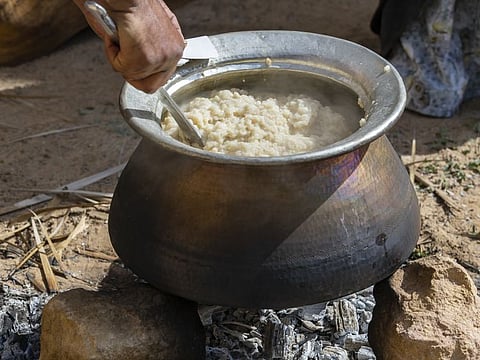Emirati traditional dish Harees is now an ‘intangible heritage’ on Unesco Representative List of Intangible Cultural Heritage
More than just a dish … how Harees brings communities closer

Dubai: Harees, the popular Emirati traditional food, has been added to the Representative List of Intangible Cultural Heritage by the United Nations Educational, Scientific and Cultural Organisation (Unesco). The porridge-like dish, which is a beloved part of the culture and cuisine of the UAE, is often served during Ramadan, at family gatherings, weddings, and national and religious holidays.
During its 18th session in Kasane, Botswana, the Intergovernmental Committee for the Safeguarding of Intangible Cultural Heritage at Unesco approved the inscription of Harees on the Unesco Representative list. The UAE led the Harees nomination file in collaboration with the Kingdom of Saudi Arabia and the Sultanate of Oman.
Celebrating symbols of heritage and culture
The addition of Harees to this list of intangible cultural heritage is part of the UAE’s ongoing efforts to preserve and carry forward the country’s historical legacies, according to Sheikh Salem bin Khalid Al Qassimi, the UAE’s Minister of Culture.
“The UAE is committed to the preservation of cultural heritage in all its forms and has championed the safeguarding of intangible cultural heritage which has the unique power to bring to life past traditions and knowledge from our ancestors,” he said.
“This part of our heritage, which has been inscribed on the Unesco’s list of intangible cultural heritage, continues to bring us closer as a people, as well as serves as a common link to those countries who share our heritage practices in the gulf, the Arab region, and international community,” he added.
The addition of Harees to the list followed joint efforts by the UAE’s Ministry of Culture, the Department of Culture and Tourism - Abu Dhabi (DCT Abu Dhabi), and the UAE National Commission for Education, Culture and Science.
Mohammed Khalifa Al Mubarak, Chairman of DCT Abu Dhabi, emphasised the significance of these collaborative efforts in preserving the authentic UAE heritage and ensuring its continuity for future generations.
“Our national heritage informs the rich Emirati cultural identity that we cherish and are so proud to share with the world,” he said.
What is the Representative List of Intangible Cultural Heritage?
Unesco’s 2003 Convention, also referred to as the Convention for the Safeguarding of Intangible Cultural Heritage, aims to safeguard the intangible cultural heritage of states and cultures from across the world. The list includes traditions or living expressions passed on over generations, such as oral traditions, performing arts, social practices, festive events, knowledge, and practices concerning nature and the universe or the knowledge and skills to produce traditional crafts.
Every year, delegates from the States that are signatories to the 2003 Convention, meet to decide whether to inscribe proposed cultural practices and expressions of intangible heritage on the Convention’s Lists.
Since signing the convention in May 2005, the UAE has successfully led efforts to inscribe 15 elements to this list, including falconry, the Al Talli traditional embroidery as well as the ‘aflaj’ traditional network system of irrigation.
What is Harees?
Harees is a traditional dish prepared by boiling wheat in slightly salted water for several hours. After that, meat (usually lamb or chicken) is added to the boiled wheat and cooked for at least four more hours. Once the dish is ready, it is served with a dollop of local ghee or clarified butter on top. When listing Harees as an intangible cultural heritage, Unesco noted how the dish held more than just culinary significance.
“The related skills and knowledge are passed on from mothers to daughters, in educational institutes, restaurants and hotels, and through the media and official institutions. Preparing and serving Harees is viewed as a sign of hospitality and generosity. A means of promoting social connection, the practice strengthens bonds between people and communities while enhancing cultural affinity in the societies concerned,” the addition to the list notes.
Sign up for the Daily Briefing
Get the latest news and updates straight to your inbox








